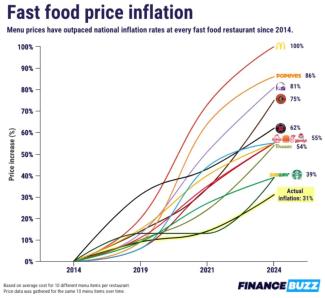
The Fast-Food Inflation Crunch: A Look at Rising Prices Since 2014
As the aroma of freshly made fries and burgers wafts through the air, so does the realization that fast food isn't as wallet-friendly as it used to be. A recent graphic provided by FinanceBuzz paints a vivid picture of how fast-food prices have soared, outpacing general inflation since 2014.
The Bite of Inflation on Fast Food
Inflation is an economic reality affecting all sectors, but the fast-food industry seems to have supersized its impact on consumers’ pockets. The graphic shows a steep climb in menu prices across major fast-food chains over the past decade, with some increases nearly tripling the rate of overall inflation. For instance, a popular fast-food chain has seen a whopping 100% increase in its menu prices, suggesting that the cost of quick convenience has become a heavier burden for everyday consumers
Understanding the Surge
What's driving this fast-food price inflation? Several factors come into play: rising minimum wages, increasing commodity prices, and operational costs, not to mention the implications of global events such as pandemics and supply chain disruptions. These elements combine to push the prices of your go-to meals higher and higher.
Impact on Consumer Choices
As a result of these price hikes, consumers might be facing a fork in the road: stick with the quick and easy fast-food options or pivot towards more cost-effective, perhaps healthier, home-cooked meals? The price trends indicated in the graphic could also have wider implications for food consumption patterns, budgeting, and nutrition, as families strive to balance cost with convenience.
The Financial Takeaway
From a financial perspective, the surge in fast-food prices is a telling indicator of changing economic conditions. It serves as a reminder of the importance of budgeting and financial planning, as even the smaller items in our daily lives, like a fast-food meal, can become significant expenses over time. The rising prices in fast-food underscore the need to adapt our spending habits to the realities of inflation
Conclusion
The graphic from FinanceBuzz offers a snapshot of an important trend in the consumer market, prompting discussions not only about the cost of fast food but also about the broader financial principles at play. As prices continue to rise, it's more important than ever to keep an eye on how these increases can affect overall financial health and to consider the value of each dollar we spend. Whether it's a cheeseburger or a chicken sandwich, the real cost might be more than what's on the price tag.

